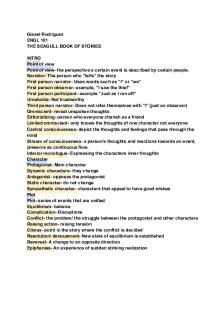Origin Stories - Assignment composed of contents from the textbook PDF

| Title | Origin Stories - Assignment composed of contents from the textbook |
|---|---|
| Author | Cobey McGraw |
| Course | Introduction to Religious Studies |
| Institution | Saginaw Valley State University |
| Pages | 2 |
| File Size | 49.2 KB |
| File Type | |
| Total Downloads | 36 |
| Total Views | 129 |
Summary
Assignment composed of contents from the textbook...
Description
Assignment: Origin Stories and Religion Cobey McGraw RS 100 Professor Teed
1. In the section on the scientific origins of religion, the author discusses anthropologist Barbara King who suggests that religion is a natural product of human evolution. Please identify the main elements of King’s argument. Does it make sense? Do you agree with it? Why or why not? King notes that “religion is common to all human cultures.” Barbara King writes, “was transformed from a basic emotional relating between individuals to a deeper relating, one that had the potential to become transcendent, between people and spiritual beings or forces.” She also states that “We humans crave emotional connection with others.” All of these elements make sense Because they all suggest that due to evolution we as a species have reformed and adapted to the primitive instincts inside of us and have been able to find a way to be morally and ethically sound while still being a human. 2. In the section on religion and belonging, the author argues that the origin of religion stems from the human need to understand the origins of reality and the place of humans and nonhumans in it. How does the Navajo sweat lodge perform this function? Do you agree that Christian baptism plays the same role? Why or why not? The Navajo performs their perception of the origins by creating dome-like framed lodges and starting a fire in the middle. One participant explained that “if you understood the earth to be a female that gave birth to creation, then you could easily see how the sweat lodge looks something like the distended, swollen belly of a pregnant woman.” This tradition clearly paints how religion stems from the human desire to understand the origins of reality. Christian Baptism much like what is mentioned in this case is very similar in the sense that you have to understand that the holy water that you are bathed in is the same water from the creation of life in the book of Genesis. 3. A key analytical concept in this chapter – and in religious studies generally – is the idea of “myth”. How does the author define myth? (please be sure to look at the text box on page 33 in addition to the other parts of the section). Are you comfortable using the word myth in relation to the creation stories of your own tradition? Why or why not? The author defines myth as a “religious explanation of an event, such as the falling of rain or thunder.” I don’t think I am personally comfortable with using the word myth to my own beliefs. I feel like if you believe in something you must believe in it one hundred percent or else you were don’t believe in it, so in my opinion the word myth must never be used in relation to creation stories of your own tradition.
4. What does the author mean when he says (using the ideas of Mercea Eliade) that myths take place “in sacred time” or “mythical time” rather than historical time? Because myths cannot be
known objectively, they are not beyond subjective knowing. This means that because we cannot prove something or show that it is indeed true it doesn’t mean that there still isn’t the possibility of it being accurate. So because of this, “myths communicate in every time and place, and the world of a myth can be experienced or imagined…” Therefore, myths take place in “sacred time” or “mythical time.”...
Similar Free PDFs

Test bank from the textbook
- 13 Pages

Origin of the Cranial Nerves
- 5 Pages

THE Seagull BOOK OF Stories
- 7 Pages

The Far Eastern Origin of the Tamils
- 27 Pages

The Origin of Species Overview
- 3 Pages

THE ORIGIN OF THE SOLAR SYSTEM
- 36 Pages

CONTENTS CONTENTS
- 455 Pages

Equity Notes from Textbook
- 25 Pages

Chapter 5 - From textbook
- 7 Pages
Popular Institutions
- Tinajero National High School - Annex
- Politeknik Caltex Riau
- Yokohama City University
- SGT University
- University of Al-Qadisiyah
- Divine Word College of Vigan
- Techniek College Rotterdam
- Universidade de Santiago
- Universiti Teknologi MARA Cawangan Johor Kampus Pasir Gudang
- Poltekkes Kemenkes Yogyakarta
- Baguio City National High School
- Colegio san marcos
- preparatoria uno
- Centro de Bachillerato Tecnológico Industrial y de Servicios No. 107
- Dalian Maritime University
- Quang Trung Secondary School
- Colegio Tecnológico en Informática
- Corporación Regional de Educación Superior
- Grupo CEDVA
- Dar Al Uloom University
- Centro de Estudios Preuniversitarios de la Universidad Nacional de Ingeniería
- 上智大学
- Aakash International School, Nuna Majara
- San Felipe Neri Catholic School
- Kang Chiao International School - New Taipei City
- Misamis Occidental National High School
- Institución Educativa Escuela Normal Juan Ladrilleros
- Kolehiyo ng Pantukan
- Batanes State College
- Instituto Continental
- Sekolah Menengah Kejuruan Kesehatan Kaltara (Tarakan)
- Colegio de La Inmaculada Concepcion - Cebu






